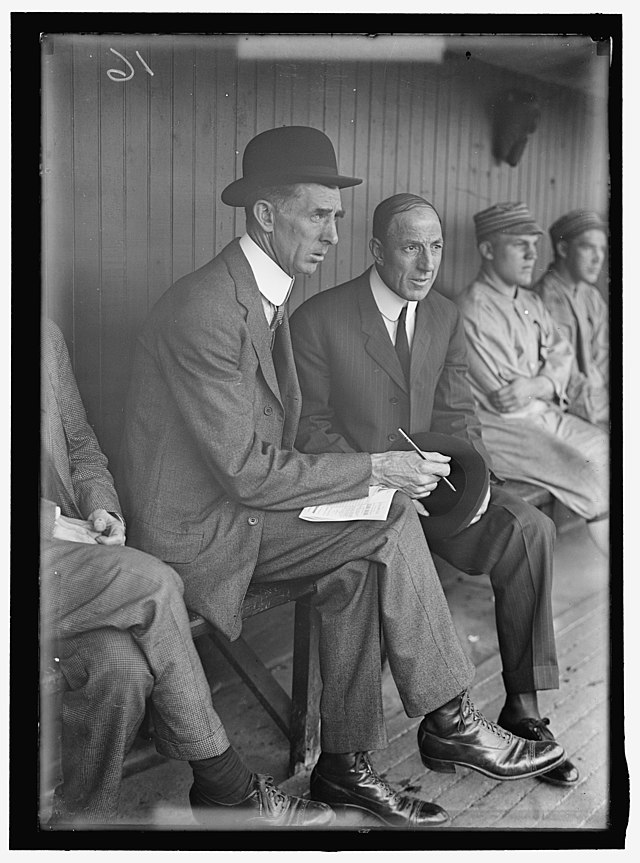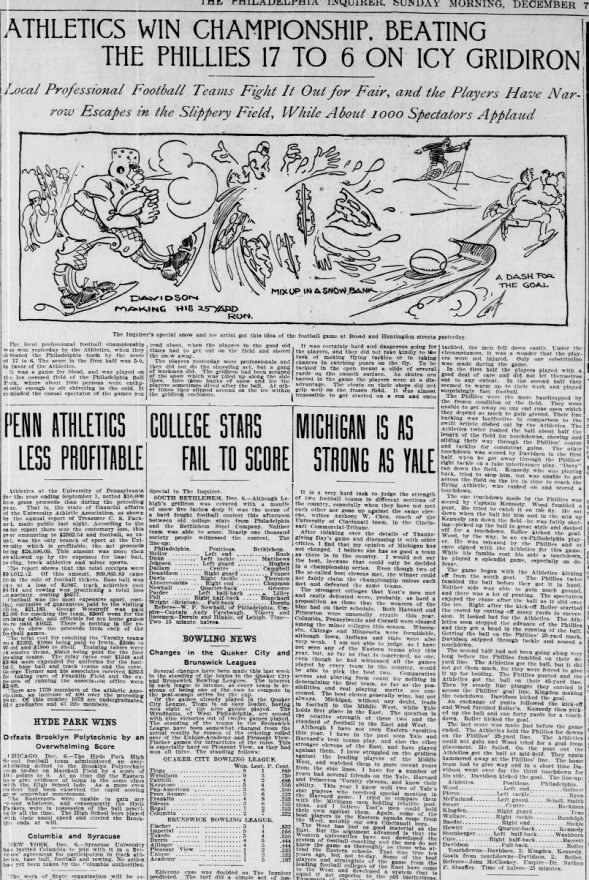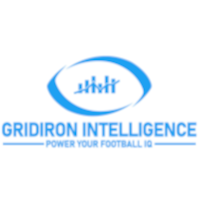In this episode, we discuss the history of the Philadelphia Phillies Professional Football team, which played in 1902.
Philadelphia Phillies Football
The Roots of Phillies Football
Even as early as shortly after the turn of the century, professional football was trying to gain a foothold. Baseball was the king of pro sport in America at the time, and with its success, some felt that the gridiron would be a logical alternative sport to follow the same pattern. The thought by some of the professional baseball franchises was to use their influence, personnel, and branding to make a mark and some money in football. One early team was the Philadelphia Phillies, owned and financed by baseball's Philadelphia Phillies ball club. The Phils began their gridiron journey as the Philadelphia Athletic Club in 1901. The group was more widely recognized around Eastern Pennsylvania as the Philadelphia Professionals or the Philadelphia Pros for short. The Pros were the first entirely professionally paid football roster in the Philadelphia area. Penn graduate, Wilson Wright, was the team’s chief financial backer and manager. One of Wright’s first moves was to bring in an experienced football man to help organize the team. Former Penn Quaker Captain Blondy Wallace was the person of choice. Captain Wallace assembled a roster of players that he was familiar with, mainly former Penn players and a few veterans of Western Pennsylvania clubs such as the Duquesne Country and Athletic Club and the Latrobe Athletic Association. Wallace was one of the tackles, while McCloskey played the other tackle position. H. A. Bull Davidson played center, Ben Doc Roller and Smith were the guards, with Stehle and Merriam were the ends. In the backfield was Kennedy at quarterback, and Washburn, a former Brown player, was positioned at halfback along with the star of this team Oscar Lang (Coach of Susquehanna University)
The 1901 edition of the Philadelpia A.C. played a fairly solid schedule against local colleges and even professional squads when they could. The inaugural campaign started well as the Pros blanked the Conshohocken Tigers, the Orange Athletic Club, and Susquehanna University. Their third game was an actual test of who the Pros were as a football team when they faced Lafayette College, a team that had stood well against Princeton and crushed all other opponents on their schedule so far that season. The Pros dispatched the Lafayette eleven rather handily in a 23-0 route. The collegians from Easton were said to have not even been able to threaten the Philadelphia goal line.
The next big test of the 1901 Professionals campaign was against a rugged Homestead Library and Athletic Club team held at the Philadelphia National League baseball grounds.[4] Many considered Homestead the top team in Western Pennsylvania in 1901 and possibly the best pro gridiron eleven in the land. The Philadelphia club built this game up as the year's Pro Football Championship. This challenge would end up being a two-game stint, with the Homestead coming out strong in the first matchup 18-0. An early muffed snap of a punt by Doc Roller provided an excellent opportunity for Homestead’s Fred Crolius to score an 8-yard touchdown a few plays later to give the Western PA team the advantage. Homestead would score again when Captain David Fultz’s squad would put up two more TDs in the second half.
The second meeting was played in Pittsburgh, and Philadelphia showed up much better, falling by a single point in a 6-5 loss to Homestead the following weekend. That single touchdown, worth five points then, was the only one scored against Homestead during the 1901 season.
Philadelphia Phillies of Pro Football

Photo is courtesy of Wikimedia Commons of Connie Mack, 1913 taken by Harris & Ewing, photographer.
The escalation of competition between the National League and American League in Baseball supremacy saw a few franchises fielding pro football teams. This was especially evident in Philadelphia as the American League’s Athletics were vying for the patronage of the fans of the City of Brotherly Love over the Phillies. Connie Mack ran the Athletics baseball team, and after winning the AL pennant in 1902, he stirred the pot of the rivalry by taking some of the Phillies baseball players, even though they were under contract. The fierce competition was really evident when Phillies' owner John I. Rogers put together a pro football team. Not to be outdone, Athletics' owner Ben Shibe looked for a way to one-up them. Shibe’s strategy of choice was to have Mack get together with Blondy Wallace and build an even better roster of players than his crosstown rival. Shibe and Rogers both wanted to be able to claim the “World Championship” title, but they knew to do so that, they had to be organized and play the powerful teams from Western Pennsylvania. A prominent figure in Pittsburgh professional football was David Berry, who had managed a few successful clubs in the Steel City area. Berry helped to build a team to compete in this new league, formulated mainly of Homestead Library players. The three decided to help formulate a league for pro football to emulate the MLB. Hence, the Phillies joined what many consider the first attempt to organize pro football, a group of three to four teams called the National Football League. This league has no connections to the current NFL other than in name only. The teams in this original NFL were the Phillies, Athletics, the Pittsburgh Stars, and, on some occasions, a New York club called the Watertown Red Blacks. There were rumors of attempts at building teams in Chicago and New York, but those never reached full fruition. Some of the boys of summer even joined in the excitement. Future Baseball Hall of Famer Rube Waddell played with the Philadelphia A’s, while pitcher Christy Mathewson was a standout fullback for the Pittsburgh Club. We will talk more about them in later posts focusing on their teams. Since the three main teams were in Pennsylvania, and the Commonwealth and a Sunday Blue Law which prevented professional sports on the Holy Day, the League would schedule all games on Saturdays.[2]
Shibe hired Albert Kennedy to lead his gridiron club. Kennedy had been a standout quarterback and played with Wallace the previous year on the Philadelphia Pros team. Ben Roller became the head coach. The National Football League of Shibe, Rogers, and Berry was scheduled to have each team play each other twice, and then the two best to vye in a championship game. [5]
This initial version of the NFL was truly a vision of parity. All three teams were fairly evenly matched. The Phillies split with the Pittsburgh Stars by falling 18-0 on November 4 in Philadelphia, only to be victorious in the game in Pittsburgh by the score of 11-0 on November 22. The two regular season games against the A's were a 6-0 loss on October 18, 1902 and then the following Saturday, October 25, had an outcome of the Phillies coming out on top 17-0. The Phillies and the Athletics would play a rubber match for the City Championship after the Leagues Championship and the Athletics bettered their counterparts by the tune of 17-6 on December 6 in this final contest.[6]
They were able to put together a schedule of games against the other League teams and with some Athletic Clubs around the East. The Phillies finished with an overall record of 8-3. It was not a bad campaign, except they were 2-3 in league play and finished third in the standings and thus did not participate in the League title game.
07 Dec 1902, Sun The Philadelphia Inquirer (Philadelphia, Pennsylvania) Newspapers.com
That was it for the Phillies football team, as in the coming months the disputes between the Philadelphia baseball teams, the Major Leagues, and owners Rogers and Shibe died down, and so did their desires to be competitive on the gridiron.
Credits
A Very Special thanks to information obtained from the following
Banner photo is courtesy of Wikimedia Commons of a cartoon from the Philadelhia Inquirer in 1902.
The other photo above is courtesy of Wikimedia Commons of Connie Mack, 1913 taken by Harris & Ewing, photographer.
References:
- Retro Seasons
- The Coffin Corner: Vol. 9, No. 6 ((1987)). "When did they start?". Professional Football Researchers Association.Professiona Football Researchers Association's Coffin Corner
- Pittsburgh Weekly Gazette: November 6, 1901 , p. 10 Quaker Stars Show up Strong
- Gridiron Legacy: Pro Football’s Missing Origin Story, Gregg Ficery, p. 84
- Phillies Nation website Phillies Nation.com
- The Philadelphia Inquirer 07 Dec 1902, Sun · Page 14 [url=https://www.newspapers.com/image/168324269/?terms=%22Athletics%22&match=1]Philadelphia Inquirer Dec 7, 1902 P 14{/url]







